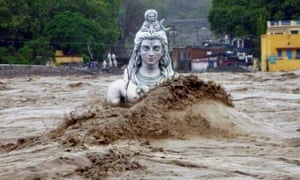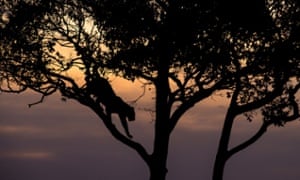
This is a collection of my published articles on travel, wildlife, and conservation.
Saturday, March 21, 2015
India falling behind in protection of snow leopards and their habitat
Indian minister is not attending the first international meeting for the conservation of snow leopards in Kyrgyzstan despite the need for greater conservation efforts to protect its leopard populations

Snow leopard walking on snow. An international forum will coordinate the conservation of the species and its habitat in Bishkek, Kyrgyzstan, on March19-20, 2015. Photograph: Tom Brakefield/Getty Images The first international steering committee meeting to coordinate conservation efforts for the snow leopard is being held in Bishkek, Kyrgyzstan, on 19 and 20 March 2015. Ministers, bureaucrats, and conservation organisations from 12 range countries are expected to attend. Sadly, India will not be represented by its minister or any of its senior bureaucrats. Read more at the Guardian

Norway may pull investment from Indian firm over Bangladesh coal plant
Norway’s pension fund may withdraw investment from a coal plant to be built with Indian partner on the edge of Sundarbans mangrove forest, citing threat of severe environmental damage


Villagers carrying oil removed from the river surface in Joymani village, Sundarbans, Bangladesh. Photograph: AP
The massive 1,320 megawatt Rampal thermal plant would sit on the edge of Sundarbans, the world’s largest mangrove forest, in Bangladesh. For more than two years, citizens, artists, and social and environmental activists protested plans to build this plant close to a forest that is a United Nations Educational, Scientific and Cultural Organisation’s world heritage site as well as a Ramsar wetland site. In September 2013, about 20,000 people marched for five days from Dhaka to Dighraj. ‘The long march’ covered a distance of nearly 250 miles, to demand the scrapping of the power plant.
The $1.2bn project is a joint venture between India’s national thermal power corporation and Bangladesh’s power development board. Environmentalists allege the plant will not only pollute the mangrove forest, but emissions from burning coal will contribute to climate change. Low-lying Bangladesh, said to be one of the most vulnerable countries in the world, is threatened by rising sea levels, but many of its citizens have no access to electricity. The government seeks to produce 20,000 megawatts of cheap coal-fired power by the year 2021. But 50% of power generated by Rampal is destined for India, while Bangladesh’s citizens and environment are expected to bear the brunt of it.
Read more at the Guardian
Update: The fund has withdrawn money not just in NTPC, but also other coal-based Indian companies.
Wednesday, March 11, 2015
Ecologically disastrous dams may get the go-ahead

The Land Below the Wind
I learnt more than my comfort level allowed about headhunting on the 30-minute drive from Kota Kinabalu to Mari Mari Cultural Village, Sabah, East Malaysia. John Prudente, the guide, briefed our group about the traditional tribal cultures showcased at the village. One of them was the Murut, the most aggressive headhunters of the Malaysian state.
Young Murut men raided other tribes to collect heads. Headhunting was a rite of passage, turning young men into warriors and eligible bachelors. But one head wasn’t enough. The greatest warrior had the most number of skulls.
John dramatically lowered his voice and said, “They would sometimes take ladies’ heads too.” My fellow tourists gasped. Since the group was all women, I suspected he was trying to get a rise out of us. But he was serious. Murut men waited in ambush by streams where women bathed and did their laundry. They were easy to overpower, and there was no law against taking their heads. John said, “The rule of the game was to get a head, a human head. It didn’t matter if it was male or female.”
But the chilling story didn’t end there. Murut warriors didn’t spare even pregnant women, and in fact, sought them out because they got two heads with one blow. “The spirit of a pregnant woman was more powerful,” John said. Not only was headhunting a mark of bravery, the spirits of the dead did the killers’ bidding. Each warrior owned a chunk of forest for hunting and procuring medicinal herbs. Since these were far away from longhouses, spirits were essential to guard them from trespassers.
Artificial glacier could help Ladakh villagers adapt to climate change

But for years the streams have run dry in spring, just when farmers needed water to sow seeds. They had water when it wasn’t needed during the rest of the year, such as in winter, when Ladakhis let water gush from taps to prevent pipes from freezing and bursting.
Villagers blame climate change for causing glaciers to shrink by melting them faster than before.
To resolve the water-shortage problem, Sonam Wangchuk, a mechanical engineer, and his team of volunteers are building a gigantic vertical block of ice in Phyang, nine miles from Leh, the capital of Ladakh. When spring comes and the artificial glacier melts, farmers will have flowing water.
The ingenious method stores water without the need for concrete water storage tanks or dams. While it won’t stop glaciers from shrinking, it could help people adapt to a warming world.
Read more at the Guardian
Carnivores in the neighbourhood
India’s laws and policies guide management of animals inside forests, but there’s no state policy to deal with predators living amongst people

STAKING TERRITORY: “Protected forests are great for conservation, but they cannot be the only strategy.” Picture shows tourists at the Tadoba-Andhari Tiger Reserve, Chandrapur. Photo: Paul Noronha
The tigress strode boldly across open farmlands, and crossed railway tracks and highways at night. She avoided venturing close to villages in her hunt for wild pigs. During the day, she hunkered down in forest patches, reed beds, or plantations, out of sight of people.
A few villagers walked within 100 metres of her hideout, but she didn’t move. In an area where the average human density is 200 per square kilometre, no one knew of her existence except a few researchers and forest officials. She wore a GPS collar that transmitted the coordinates of her location by text message several times a day for four months.
Contrary to popular belief that tigers need to live in vast forests, this tigress was 45 kilometres away from the nearest one, Tadoba-Andhari Tiger Reserve. The collar stopped functioning after four months, but a camera trap took her photograph in the same area a year later. She wasn’t a lone tiger struggling to survive in a less than ideal habitat; two other tigers lived nearby. Despite living so close to humans, she posed no threat to them.
Impediment to survival
When wild carnivores are found far outside forests, managers and conservationists often grasp for excuses. Wild animals prefer wild habitats, we are told. If they are found anywhere else, there must be something wrong. Lack of habitat, disturbance within forests, and lack of prey are oft-cited reasons. After visiting the farmlands of Akole, Maharashtra, where leopards live among people without causing alarm, one forester exclaimed to the biologist studying them, “These leopards are not normal.”
Animals disregard not only our boundaries but also our assumptions. They go where there is prey, whether domestic, feral or wild, and they live in what little cover is available. The only possible impediment to their survival in landscapes where humans live is the level of tolerance of people. Our religious and cultural traditions are empathetic of almost all animals including venomous snakes.
Regional folk deities like Waghoba in western India and Dakshin Ray in Bengal or a pan-Indian goddess such as Durga bestow sanctity on large wild cats. Even in an extreme situation like in the Sunderbans, where more people are killed by tigers than anywhere else, no one demands that all tigers be killed. It’s because of this tolerance that India still has the largest population of wild tigers in the world despite our high human population.
In comparison, European folk tales traditionally demonise predators, and fear of them runs deep. Even though human densities are relatively low, Europeans almost eradicated their carnivores. Brown bears used to be found throughout Europe except in Iceland and the Mediterranean Islands. By the mid-20th century, they were holding out in the east, north, and west of Europe.
Similarly, much of the continent was wiped clean of its wolves after the Second World War, but they managed to survive in the three Mediterranean peninsulas, Eastern Europe, and the Balkans. The number of Eurasian lynx also diminished, and they survived only along the margins of international borders. This dismal situation has changed.
A new assessment, ‘Recovery of large carnivores in Europe’s modern human-dominated landscapes,’ by 76 authors from 26 countries, was published in Science in December 2014. It shows that like the tigress outside Tadoba, carnivores are recolonising Europe, ranging far outside protected forests and staking territories among human-owned farms and plantations.
From the margins of Europe, wolves have recolonised more than 15 per cent of the land. They’ve returned to countries from where they had been declared extinct such as Norway, Poland, Latvia, Germany, and Bulgaria. Even though brown bears are huge, weighing an average 200 kilogrammes, they are now the continent’s most abundant carnivore. About 17,000 bears roam over 4,85,400 sq.km., about 10 per cent of Europe.
This turnaround was achieved after decades of coordinated legislation, good law enforcement, and public support for conservation. Instead of antagonising local people by outlawing their hunting traditions, management plans incorporated such practices and promoted recovery of animal populations. And therein lies a lesson for India.
The separation model
India’s primary conservation model, borrowed from the U.S., is to create exclusive zones, separating people from predators. Carnivores need plenty of space, and American parks, free of settlements, are large enough to accommodate them. They remove any predators found outside designated wildlife areas that take livestock.
Few parks in India are devoid of settlements and not many are large enough to maintain good breeding populations. We apply the separation model as it suits us. People living in forests have to relocate to make space for predators. But if the state removes carnivores living outside forests, there won’t be many of them left. Our laws and policies guide management of animals inside forests, but there’s no state policy to deal with predators living amongst people.
People living around forests have a long history of living with predators. Generally, they tolerate some level of loss before complaining to the Forest Department. But these complaints may not always be straightforward. Often, people are at loggerheads with the forest department. They may express their unhappiness by asking the department to remove “the government’s animals” from their property. Wildlife symbolises the state and its callous policies.
After decades of treating their carnivores as vermin, many European countries worked hard to get them back. We haven’t yet hit a low like Europe did, but we are headed that way if we don’t turn the ship around. For instance, tigers, once found across the subcontinent, now range over a mere 2.5 per cent of our country. If the species has to regain at least some lost ground, we need to do more than focus on protected areas. Biologists advocate lifting our heads and looking at the landscape. This is also where numerous people live and they decide if they want to live with predators. Antagonising them isn’t going to achieve conservation ends.
By following a coexistence model, the Europeans not only managed to bring back carnivores, they have proved it works. Europe now has twice as many wolves as the U.S., excluding Alaska. More than 12,000 wolves range across a continent that’s half the size of the U.S. and has more than twice the density of people, 97 people per sq. km. compared to the U.S.’s 40. While protected forests are great for conservation, they cannot be the only strategy. It’s time India learned from the European experience.
(Janaki Lenin is the author of My Husband and Other Animals. She writes of the intermingled destinies of humans and wild creatures.)
Published in The Hindu Comment January 9, 2015
Mumbai residents learn to live with leopards
A unique participatory initiative in Mumbai helps residents deal with their fear of living with leopards

Leopards are adaptable creatures, living where ever there is plenty of rubbish and stray dogs Photograph: Paul Goldstein/Exodus/REX Residents reported seeing a leopard prowling around their village of Marodi, Karnataka. One news report claimed the animal the animal had not taken any livestock, while another said the cat had killed a calf. Importantly, the animal hadn’t threatened a human or displayed aberrant behaviour. Read more at the Guardian

Leopards in the neighbourhood
If leopards can live off anything and live anywhere, what are our options of managing them?
Published in BBC Wildlife December 2014.
Published in BBC Wildlife December 2014.
Subscribe to:
Posts (Atom)

